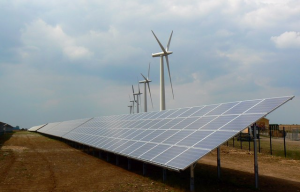September 16, 2015 – Vol. 10 Issue 3: Prop 39 and the Bad Rapp
In This Issue
Flanigan’s Eco-Logic
The Federal Clean Power Plan
Mass DOT Goes Solar
Almond Farming and CA Water
What to Drink?
The San Onofre Solution

Flanigan’s Eco-Logic: Prop 39 and the Bad Rapp
The Climate Smart Schools team is now working in five California school districts implementing Proposition 39, the California Clean Energy Jobs Act. For the past two years our team has been benchmarking, auditing, evaluating products, and creating smart energy management plans that serve the particular needs of each district.
Still, eighteen months in and not one of the districts have yet “broken ground” on construction. Wow. Does this delay mean that Proposition 39 is a failure? Far from it.
In August, the Associated Press (AP) authored a report that Prop 39 has failed in making good on the jobs it promised. Based on our experience, the real jobs are coming. In the next eighteen months, if our work is any indication, we can anticipate a major wave of energy efficiency work in California.
Energy plans have been approved by school district boards and by the California Energy Commission, a major hurdle. Checks have been cut by the California Department of Education. Money is about to flow.
In our pipeline, we’re shifting into implementation at five high schools and five elementary schools. On these ten campuses, there will be lots of workers replacing lighting, reprogramming and in cases installing more efficient HVAC. Those are real jobs. We’re also addressing pools, heaters, pumps, controls, and covers. Our job creation contribution as a result of implementation will be 31.8 full-time equivalent jobs and nearly a half million in energy and dollar savings in the first year alone.
And that’s just round number one. The work continues. We’re about to file a second round of Energy Expenditure Plans for the current fiscal year. And we have three other districts with their first plans ready to go. None of these plans have yet to be calculated for jobs and energy savings. When these milestones are reached, Prop 39 will have significant impact.
As a Prop 39 consultant – Climate Smart Schools – it’s hard not to defend the planning funds allocated. From our nonprofit vantage point, we don’t see any abuse of funds. Instead, we see a range of project types, from very basic retrofits to quite complex energy management projects co-mingled with other funds. One can paint a rich tapestry of approaches and concepts being put in motion thanks to Prop 39, all deemed cost effective by the infamous “SIR,” the savings to investment ratio.
Furthermore, the level of planning seems appropriate. Planning funds were capped for most districts at 30% of the first-year allocation, or some 6% of a district’s overall P39 five-year allocation. And for that amount, our districts are getting great value, roadmaps for long-term savings, complete with vetted and approved strategies for retrofit and generation projects, their financing and implementation.
When fully realized, and amplified by student and community involvement and action, Climate Smart School districts will realize significant savings, and many jobs and careers will have been created. We suspect that many districts up and down the state can talk about their successes.
Thanks to our involvement, and planning support, Climate Smart Schools is providing added value to districts: our schools are working on the nexus between energy and water and carbon. We helped one district win a $2 million grant for smart water management on campus. Students are getting involved. We’re exploring solar and energy storage. And with our utilities, we’re shaping up a Zero Net Energy project, transforming the science wing of one of our high schools into a living lab for students and the surrounding design community.
Sure, Prop 39 has its problems, but AP missed the mark. The real story is that the pipeline is being loaded. And yes, too many districts and schools are sitting on the sidelines. We urge them to jump in and to become a part of a successful school energy efficiency retrofit movement at this program mid-point.
Stay tuned. We look forward to reporting on actual retrofits, that take lots of workers and that will be resulting in lower costs for districts, while shaping careers in California’s clean tech arena.

 On August 3rd President Obama and the U.S. Environmental Protection Agency announced the Clean Power Plan. It “takes real action on climate change,” cutting carbon emissions nationwide 32% before 2030 from 2005 levels. Obama called the initiative as the nation’s most important step to address climate change. Federal officials hope that the Plan will leverage international adoption of similar rules. Detractors have called the initiative a “war on coal” with crippling economic impacts.
On August 3rd President Obama and the U.S. Environmental Protection Agency announced the Clean Power Plan. It “takes real action on climate change,” cutting carbon emissions nationwide 32% before 2030 from 2005 levels. Obama called the initiative as the nation’s most important step to address climate change. Federal officials hope that the Plan will leverage international adoption of similar rules. Detractors have called the initiative a “war on coal” with crippling economic impacts.


 It wasn’t that long ago that being a milkman was a career option. And only one kind of milk was in the truck. But today, there’s whole, skimmed, almond, rice, and soy and more. Dairy milk per capita dropped by 25% from 1975 – 2012. Since 1999, alternatives’ growth rates have been 10% annually. But now the drought. The plot thickens. Which is best for you? Which is milk is best for our society in time of drought?
It wasn’t that long ago that being a milkman was a career option. And only one kind of milk was in the truck. But today, there’s whole, skimmed, almond, rice, and soy and more. Dairy milk per capita dropped by 25% from 1975 – 2012. Since 1999, alternatives’ growth rates have been 10% annually. But now the drought. The plot thickens. Which is best for you? Which is milk is best for our society in time of drought?